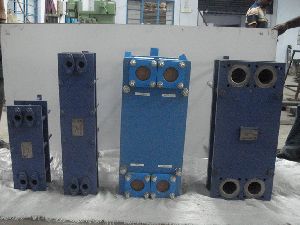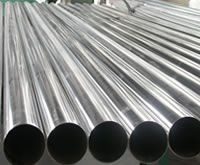
PLATE FIN TYPE HEAT EXCHANGER
Get Price Quote
the plate bundle of a plate-fin heat exchanger is composed of fin, division plate and seal packing. A fin and a seal packing, which are placed in between two adjacent division plates, form an interlayer called as passage. The interlayers are superposed into a whole by brazing, according to different flowing ways of fluid, forming the bundle of plate (or called core body). aluminum is applicable to dip brazing with salt solution, so at present the plate-fin heat exchanger is nearly made of the manganese-aluminum alloy, which is corrosion-resistant.the plate-fin heat exchanger usually is fabricated from aluminum, but regardless of the materials of construction, the core is furnace brazed in a controlled atmosphere or high vacuum. Because plate-fin heat exchangers require more precise manufacturing, they are usually more expensive than other designs. features of plate-fin heat exchanger main features of plate-fin heat exchanger are as follows:1. high heat transfer efficiencythe heat transfer efficiency is high is that the fin can cause the disturbance for the fluid to make the thermal boundary layer rupture and renew continuously. The heat transfer coefficient of forced convective gas is 35 to 350 w/ (m2·℃), the overall heat transfer coefficient of forced convective oil is 120 to 1740 w/ (m2·℃), while the overall heat transfer coefficient of gas-gas in the shell-and-tube heat exchanger is only 10 to 35 w/ (m2·℃). 2. compact structure and light weightits heat transfer area per unit volume is generally 1500 to 2500 m2/m3, which is 8 to 20 times that of the shell-and-tube heat exchanger. The weight of aluminum plate-fin heat exchanger is one tenth that of the shell-and-tube heat exchanger with the same heat transfer area, but its metal consumption per unit heat transfer area can be dozens of times smaller than the shell-and-tube heat exchanger. 3. wide range of application it can be applicable to the heat transfer of various different fluids such as gas to gas, gas to liquid and liquid to liquid. Depending on the arrangement and combination of various flow passages, the plate-fin heat exchanger can adapt to the heat transfer in different working conditions such as countercurrent, cross flow, multi-flow and multi-pass flow. The plate-fin heat exchanger can be shaped and produced in batch to meet different requirements, so the cost can be reduced and the interchangeability is enlarged. 4. the manufacturing process is complicated and the requirements for manufacture are strict. 5. it is easy to be blocked and the cleaning and maintenance are difficult. If the inner leakage occurs owing to the corrosion, it is hard to maintain the exchanger. in the practical production, the plate-fin heat exchangers made of aluminum are used for air separation device, petrochemical device and mechanical power equipment, and their service ranges are as follows:the design temperature is from -200 to 150℃, and the design pressure is from 0 to 0.6mpa.

Plate finned type Heat Exchanger
Get Price Quote
We are the leading manufacturers of Plate finned type Heat Exchanger in India. PFHE are Classified based on the Application : 1. Refrigeration Condensers2. Air Coolers3. Air Heaters4. Steam Condensers5. Compressor Inter cooler and After coolers Oil refineries, Power Plants, Food Industries and Processing Industries are mainly using the Plate Finned Type Heat Exchangers for Condensation and Refrigeration purpose. Material of Construction : 1. Copper Tubes2. Aluminum Fins or Foils3. Copper Alloy tubes4.Carbon steel Casings5. Stainless steel casings Air Heater using blowers and Ducting system Air Heaters and Air coolers : The ultimate use of Plate finned Heat Exchangers are Air cooling and Air heating. Here the Air to be cooled or Heated is flows through the Fin side. i.e Air flows across tubes. And Cooling or Heating medium is passes through the tubes. i.e Steam or refrigerant. Heaters : When Cold Air comes from the system (or) Atmosphere it passes across the tubes, Tubes carrying of Hot Fluid (or)Steam will comes enters in to tubes. Due to temperature difference between the both sides. Heat gets transfers from Hot fluid to cold fluid through conductive tubes. The Required heat transfer area to achieve the Heating of air to required temperature is arrived using the standard Heat duty relations. The flow of Air may be forced or Induced flow based on application. Heat Lost by Hot fluid = Heat gain by Cold fluid Air coolers :: In the same way of Heating, Air coolers also working in the same principle. Here tubes will carry the cold fluid. i.e Refrigerant. Due to temperature difference between the both sides. Heat gets transfers from Hot fluid to cold fluid through conductive tubes. The Required heat transfer area to achieve the Heating of air to required temperature is arrived using the standard Heat duty relations. Air will pass the Heat to the Refrigerant, Based on the LMTD between the fluids. In maximum cases the Air is sucked from the atmosphere using the air blowers and filters. Features: For Quality Fins we use Virgin 1100 grade aluminum. As per the ASTM B280 Standards Internal Cleaning System for Coil are designed. We tested our coil at 400 PSI of dry nitrogen pressure. A Plate finned type Heat Exchanger is the most common type of heat exchanger in all manufacturing Industries. To know the plate fin heat exchanger cost mail us your requirements.
Best Deals from Plate Heat Exchangers

Plate Type Heat Exchanger
Get Price Quote
Plate heat exchangers have a high heat transfer rate compared to other types of heat exchangers due to their large surface area. They are composed of a number of thin metal plates compressed together into a ‘plate pack’ by two pressure plates. Within a plate heat exchanger, the fluid paths alternate between plates allowing the two fluids to interact, but not mix, several times in a small area. Each plate is corrugated to increase the surface area and maximize heat transfer. plate heat exchangers have a number of applications in the pharmaceutical, petrochemical, chemical, power, industrial dairy, and food & beverage industry.

Plate Heat Exchanger
Get Price Quote
We are counted among the most prominent Plate-Type Heat Exchanger Exporters from Tamil Nadu. Our Plate Heat Exchanger comprises of various corrugated metal plates with holes between the two fluids through which transfer of heat can take place. Herein, the sizes and number of the plates are determined by the physical properties of the fluids, flow rate, temperature program, and pressure drop. With efficient manufacturing capabilities, we are able to offer customized designs of Industrial Plate Heat Exchanger as per the need of the client.

Plate Heat Exchangers
Get Price Quote
Plate Heat Exchangers is a type of heat exchanger that uses metal plates to transfer heat between two fluids. This is a major advantage over a conventional heat exchanger in that the fluids are exposed to a much larger surface area because the fluids spread out the plates. This facilitates the transfer of heat, and greatly increases the speed of the temperature change. It is not as common to see plate heat exchangers because they need well-sealed gaskets to prevent the fluids from escaping, although modern manufacturing processes have made them feasible.

Plate Type Heat Exchanger
Get Price Quote
A plate type heat exchanger is a type of heat exchanger that uses metal plates to transfer heat between two fluids. This has a major advantage over a conventional heat exchanger in that the fluids are exposed to a much larger surface area because the fluids spread out over the plates. This facilitates the transfer of heat, and greatly increases the speed of the temperature change. It is not as common to see plate heat exchangers because they need well-sealed gaskets to prevent the fluids from escaping, although modern manufacturing processes have made them feasible. The concept behind a heat exchanger is the use of pipes or other containment vessels to heat or cool one fluid by transferring heat between it and another fluid. In most cases, the exchanger consists of a coiled pipe containing one fluid that passes through a chamber containing another fluid. The walls of the pipe are usually made of metal, or another substance with a high thermal conductivity, to facilitate the interchange, whereas the outer casing of the larger chamber is made of a plastic or coated with thermal insulation, to discourage heat from escaping from the exchanger. The plate heat exchanger (PHE) was invented by Dr Richard Seligman in 1923 and revolutionized methods of indirect heating and cooling of fluids. Plate type heat exchanger one is composed of multiple, thin, slightly-separated plates that have very large surface areas and fluid flow passages for heat transfer. This stacked-plate arrangement can be more effective, in a given space, than the shell and tube heat exchanger. Advances in gasket and brazing technology have made the plate-type heat exchanger increasingly practical. In HVAC applications, large heat exchangers of this type are called plate-and-frame; when used in open loops, these heat exchangers are normally of the gasket type to allow periodic disassembly, cleaning, and inspection. There are many types of permanently-bonded plate heat exchangers, such as dip-brazed and vacuum-brazed plate varieties, and they are often specified for closed-loop applications such as refrigeration. Plate heat exchangers also differ in the types of plates that are used, and in the configurations of those plates. Some plates may be stamped with “chevron” or other patterns, where others may have machined fins and/or grooves. Specifications : Liquid foods such as milk, fruit juices, beers, wines, and liquid eggs are pasteurized using plate-type heat exchangers. Wine and fruit sjuices are normally deaerated prior to pasteurization in order to remove oxygen and minimize oxidative deterioration of the products. Plate-type heat exchangers consist of a large number of thin, vertical steel plates that are clamped together in a frame. Applications : The plates produce an extremely large surface area, which allows for the fastest possible transfer. Making each chamber thin ensures that the majority of the volume of the liquid contacts the plate, again aiding exchange. The troughs also create and maintain a turbulent flow in the liquid to maximize heat transfer in the exchanger. A high degree of turbulence can be obtained at low flow rates and high heat transfer coefficient can then be achieved. Advantages : Easy maintenance and suitable for CIP, plate pack easily accessible High heat transfer coefficients Flexibility to change plate arrangement and to add or remove plate No mixing of product Compact constructions Optimized heat recovery

Stainless Steel Plate Heat Exchanger
Get Price Quote
Stainless steel's resistance to corrosion and staining, low maintenance and familiar lustre make it an ideal material for many applications. There are over 150 grades of stainless steel, of which fifteen are most commonly used. The alloy is milled into coils, sheets, plates, bars, wire, and tubing to be used in cookware, cutlery, household hardware, surgical instruments, major appliances, industrial equipment (for example, in sugar refineries) and as an automotive and aerospace structural alloy and construction material in large buildings. Storage tanks and tankers used to transport orange juice and other food are often made of stainless steel, because of its corrosion resistance and antibacterial properties. This also influences its use in commercial kitchens and food processing plants, as it can be steam-cleaned and sterilized and does not need paint or other surface finishes.

Plate Heat Exchangers
1 Per -

Plate Type Heat Exchanger
Get Price Quote
Plate Type Heat Exchanger, skid mounted cooling tower, Rcc Cooling Tower

Spiral Plate Heat Exchanger
Get Price Quote
Spiral Plate Heat Exchanger, wood splitter